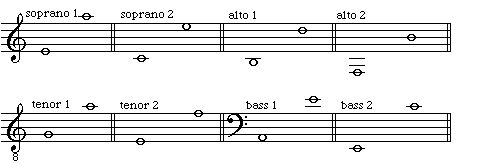Choral Arranging and Composition
I. Vocal Ranges
The range of a voice can be divided into sub-ranges, each with its particular
characteristic and effect on the performer.

Conversational range
A comfortable mid-range which covers about a fifth or sixth, easy to sustain over long
periods of time, supports relaxed or low tension moods, sustained use does not
promote interest
Standard range
Above and below the conversational mid-range, high range supports increased
intensity of mood, low range supports decreased intensity of mood, sustained use
of a single part of this range does not promote interest
Extreme range
Effective at climaxes and anti-climaxes, constant unrelieved use of an extreme can
quickly become wearing to both the singer and the listener.
Voice Ranges

II. Divisi Ranges

III. Effect of different range, spacing, and density configurations.
If the composer or arranger keeps the voices in a continuous tutti within a
particular range and spacing pattern over an extended period of time, the
listener may lose interest in the music. On the other hand, the listener's
interest can be refreshed periodically by doing any or all of the following:
- Vary the number of voices. Let one or more of the voices rest from time to
time. Try different couplings and groupings of voices. For example, make a
pair of voices move in more rapid motion that another more sustained voice.
- Vary the spacing between voices. Change from homogeneous to heterogeneous
spacings to make a particular voice stand out.
- Transfer active lines from part to part.
- High groupings of voices can support a climax or intense mood.
- Low groupings of voices can support a mood of serenity and restfulness -- or
resignation and sadness.
- Closely spacing voices in the mid-range (upper voices low, lower voices high)
creates a resonant intense effect.
- Antiphonal effects: dialogs, overlaps between groups of voices (one starts
before the other stops; contrasting alternation between groups of voices.
- Texture control: monorhythmic vs. polyrhythmic, homophonic vs. multi-linear;
contrast of types of texture.
Steady State vs. Change
- Steady state (use of selected elements or tools with no change, addition or
subtraction)
- Gradual, progressive change
- Abrupt contrast
- Frequent exchange between two (or more) states
- Move to a new state then return to the original
Some examples of "states" include high/low, dense/sparse, closed/open, active/inactive,
texture type, homogeneous/heterogenous.
Some Variation Techniques
Texture (see Texture pages in Composer's Tools).
for example, change from homogeneous tutti to accompanied solo, feature a small
group within the larger group, add new elements each time music is repeated such as
additional lines or elaboration, put melody in another voice, double melody in two
or more voices, change the type of texture, feature different parts of the choral
tessitura.
Harmony
for example, add new colors, change key, change mode, contrast
between diatonic modes or between diatonic and chromatic passages.
Rhythm
for example, change relative activity and complexity, add or delete
rhythmic layers.
Voice sub-groupings
for example, add enough space between two pairs of voices to produce
dichotomy, progressive addition or deletion of voices (density crescendo or
diminuendo), other kinds of progressive addition or deletion ("wave," "pyramid,"
"fan," "parallel sweep"). See Voice Density Patterns below.
Voice couplings
pairings, two contrasting pairs, one voice contrasting with the others,
faux bourdon, parallelism (chord streams, chord planing), chord-stream counterpoint.
Voice Density Patterns
These patterns can be used to avoid unrelenting use of SATB, to
set up contrasts, to create conversation-like exchanges in
the choir and so on. The patterns listed below are common but do
not rule out unlisted possibilities.
2
3
4
2 + 2
3 + 3
3 + 2
4 + 2
4 + 3
4 + 4
|
(SA or TB)
(SSA or TTB)
(SSAA, TTBB, SATB)
(SA + TB) (SS + AA, TT + BB)
(SSA + TTB)
(SSA + TB)
(SSAA + TB)
(SSAA + TTB)
(SSAA + TTBB)
|
More useful ideas for choral writing can be found by visiting Textures and other
Tools pages.
Notice the effects and long-range plans created by these ideas in selected
choral scores and recordings.
Return to Composer's Tools.
Return to Composition Page.
Return to Ken Rumery's home page.
Copyright © 1996, Kenneth R. Rumery, all rights reserved.


